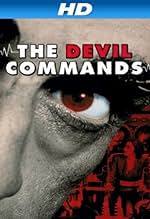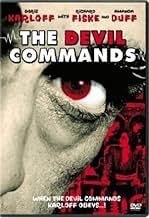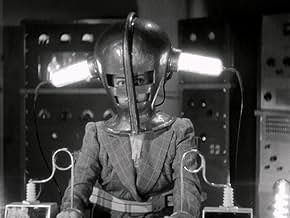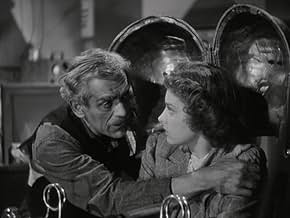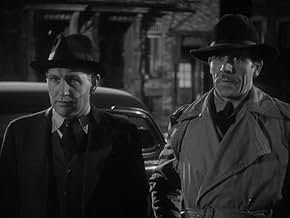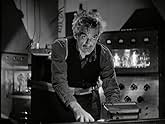CALIFICACIÓN DE IMDb
6.1/10
1.6 k
TU CALIFICACIÓN
Agrega una trama en tu idiomaScientist becomes obsessed with the idea of communicating with his dead wife.Scientist becomes obsessed with the idea of communicating with his dead wife.Scientist becomes obsessed with the idea of communicating with his dead wife.
- Dirección
- Guionistas
- Elenco
Ernie Adams
- Elam
- (sin créditos)
Lester Allen
- Dr. Van Den
- (sin créditos)
Wheaton Chambers
- Dr. Sanders
- (sin créditos)
Earl Crawford
- Johnson
- (sin créditos)
Harrison Greene
- Mr. Booth, Bakery Proprietor
- (sin créditos)
Erwin Kalser
- Professor Kent
- (sin créditos)
Eddie Kane
- Professor Walt
- (sin créditos)
George McKay
- Station Agent
- (sin créditos)
Al Rhein
- Truck Driver
- (sin créditos)
- Dirección
- Guionistas
- Todo el elenco y el equipo
- Producción, taquilla y más en IMDbPro
Opiniones destacadas
As for another viewer, this film was deposited in my memory banks a generation ago. This morning (4 Sept 2007) the TCM screen stirred that memory, so I taped and replayed the conclusion. The content is thin but the film is short, at least for a grown-up. Karloff is splendid, perfectly absorbed as ever in his character. His role is well supported by the evil medium-familiar woman with regulation severely-pulled-back hair. Dmytryk's touch is in evidence already, as every scene is well composed and lighted.
But the reason why the film stuck in my aging memory, and the only reason for it to attract attention, is the stunningly realized seance scenes at the end. As other posters have described, this isn't just any seance: most of the participants have already crossed over, but they look bewitchingly cool sheathed in deco metal suits. (Another poster called them diving suits, but more like space suits you'd find on the covers of Amazing Tales in that era.) In classic seance style, all these suited bodies are seated around a table.
As in Frankenstein and so many other movies since, the action in the lab scene mostly involves turning up the juice, which pours through the whole interlinked seance, adding a lot of hypnotic background noise. (And can be defended historically, since Spiritualists often used electro-magnetic metaphors to describe their rapport.)
What happens then testifies to a lesson later film-makers probably can't re-learn: nothing is more suggestive than restraint. In two concluding scenes where Karloff finally gets the experiment up and running the way he planned, this well-built seance scenario comes to partial but mesmerizing life. A spinning vortex appears at the bodies' center. The voice of Karloff's dead wife breaks through in a grinding electronica: "Julian!"
Then a lovely, unpredictable action: the seance cadavers in their space suits move ever so slightly, bowing toward the vortex in a series of click-actions. Then, when the electricity ceases, they click back into upright postures. Just as the Karloff character hears his wife's voice, something strangely suggestive of life beyond death occurs. The scene lasts only seconds but is repeated for the mob-finale. It's like an Eric Clapton solo, where you're touched less by what is actually played than all that might have been played. The performance stops at its peak moment, launching the audience's imagination in a way that extensions of the scene could never have accomplished.
But the reason why the film stuck in my aging memory, and the only reason for it to attract attention, is the stunningly realized seance scenes at the end. As other posters have described, this isn't just any seance: most of the participants have already crossed over, but they look bewitchingly cool sheathed in deco metal suits. (Another poster called them diving suits, but more like space suits you'd find on the covers of Amazing Tales in that era.) In classic seance style, all these suited bodies are seated around a table.
As in Frankenstein and so many other movies since, the action in the lab scene mostly involves turning up the juice, which pours through the whole interlinked seance, adding a lot of hypnotic background noise. (And can be defended historically, since Spiritualists often used electro-magnetic metaphors to describe their rapport.)
What happens then testifies to a lesson later film-makers probably can't re-learn: nothing is more suggestive than restraint. In two concluding scenes where Karloff finally gets the experiment up and running the way he planned, this well-built seance scenario comes to partial but mesmerizing life. A spinning vortex appears at the bodies' center. The voice of Karloff's dead wife breaks through in a grinding electronica: "Julian!"
Then a lovely, unpredictable action: the seance cadavers in their space suits move ever so slightly, bowing toward the vortex in a series of click-actions. Then, when the electricity ceases, they click back into upright postures. Just as the Karloff character hears his wife's voice, something strangely suggestive of life beyond death occurs. The scene lasts only seconds but is repeated for the mob-finale. It's like an Eric Clapton solo, where you're touched less by what is actually played than all that might have been played. The performance stops at its peak moment, launching the audience's imagination in a way that extensions of the scene could never have accomplished.
Corny and cliche'd as The Devil Commands may look to the superficial gaze, it's a powerful expression of the inextinguishable and far from trivial human wish to believe that death is not the end and that the dead we loved are not forever lost to us. Karloff starred in a whole sub-genre of films on this theme from the middle 1930s to the early 1940s (cf The Invisible Ray, Before I Hang, The Man They Could Not Hang, etc), invariably as a misunderstood scientific genius, embittered by tragedy or injustice, whose desire to conquer death clashes fatally with the prerogatives of the Almighty.
Whether one believes in an afterlife or not, it would be a coarsely reductionist mind that could consider the subject ridiculous. What gives these films (and this one in particular) their eerily modernist slant on the matter lies in the way they reflect the public's awe of science in the first half of the twentieth century, when astonishing developments such as radio and television (and that weird form of immortality, the motion picture), made it seem believable that technology might solve the supernatural as well as the physical mysteries. It is worth remembering in this context that the contemporary electrical wizards Thomas Edison and Nikola Tesla, classical Mad Scientists both, attempted to build machines with which to talk to the dead.
In this morbidly obsessive cinematic byway The Devil Commands stands out as one of the most insidiously poignant and nearly blasphemous films of its kind, sailing very close to the emotional and spiritual wind in its depiction of Karloff's bizarre attempts to communicate with his dead wife. As a mad-scientist entertainment it contains some of the most magnificently deranged laboratory scenes ever filmed, surpassed in this context only by James Whale's Frankenstein and Bride Of Frankenstein. I still succumb to its mournful fascination. And if your first viewing doesn't scare you half to death, you can't be more than half alive.
Whether one believes in an afterlife or not, it would be a coarsely reductionist mind that could consider the subject ridiculous. What gives these films (and this one in particular) their eerily modernist slant on the matter lies in the way they reflect the public's awe of science in the first half of the twentieth century, when astonishing developments such as radio and television (and that weird form of immortality, the motion picture), made it seem believable that technology might solve the supernatural as well as the physical mysteries. It is worth remembering in this context that the contemporary electrical wizards Thomas Edison and Nikola Tesla, classical Mad Scientists both, attempted to build machines with which to talk to the dead.
In this morbidly obsessive cinematic byway The Devil Commands stands out as one of the most insidiously poignant and nearly blasphemous films of its kind, sailing very close to the emotional and spiritual wind in its depiction of Karloff's bizarre attempts to communicate with his dead wife. As a mad-scientist entertainment it contains some of the most magnificently deranged laboratory scenes ever filmed, surpassed in this context only by James Whale's Frankenstein and Bride Of Frankenstein. I still succumb to its mournful fascination. And if your first viewing doesn't scare you half to death, you can't be more than half alive.
BORIS KARLOFF is a scientist who wants to communicate with the brain waves of his dead wife. His daughter narrates the tale and concludes with: "It is dangerous to communicate with the dead." That's about the impression the viewer gets after seeing what happens in the course of a brisk one hour and six minutes.
Columbia produced this low-budget feature and gave the directing chores to Edward Dmytryk, who would later go on to bigger and better things at RKO. But it's an efficient thriller thanks to his direction and the low-key, shadowy photography that makes the absurd story at least come to life on occasion.
Enjoyable too are the performances of ANN REVERE as a sinister housekeeper who knows all about Karloff's experiments and what goes on behind the locked doors of his laboratory; DOROTHY ADAMS as an inquisitive servant who agrees to check out the lab and gets locked inside; and KENNETH MacDONALD as the Sheriff determined to find out who is responsible for all the missing bodies from the graveyard.
It's typical Karloff stuff and he lends his commanding presence to the role with more dignity than it deserves. If it emerges as a better than average horror vehicle, it's because director Dmytryk is at the helm, but the script is absurd. The low-budget production values are neatly hidden by all the shadowy photography.
Columbia produced this low-budget feature and gave the directing chores to Edward Dmytryk, who would later go on to bigger and better things at RKO. But it's an efficient thriller thanks to his direction and the low-key, shadowy photography that makes the absurd story at least come to life on occasion.
Enjoyable too are the performances of ANN REVERE as a sinister housekeeper who knows all about Karloff's experiments and what goes on behind the locked doors of his laboratory; DOROTHY ADAMS as an inquisitive servant who agrees to check out the lab and gets locked inside; and KENNETH MacDONALD as the Sheriff determined to find out who is responsible for all the missing bodies from the graveyard.
It's typical Karloff stuff and he lends his commanding presence to the role with more dignity than it deserves. If it emerges as a better than average horror vehicle, it's because director Dmytryk is at the helm, but the script is absurd. The low-budget production values are neatly hidden by all the shadowy photography.
A likable horror/sci-fi (given a catchpenny but utterly meaningless title!) tailor-made for its star despite its naïve approach to the supernatural (what with the goofy laboratory equipment that's a cross between medieval torture devices and an underwater suit!). The Gothic trappings included in the narrative (mystery house, seances, brutish 'zombie' manservant) don't sit too well alongside the scientific paraphernalia and jargon and actually cheapen the film, though not quite to the level of the contemporaneous Bela Lugosi vehicles made by Poverty Row studios!
Perhaps the most perplexing element in the film is the constant narration, which doesn't really serve any purpose: this was probably inspired by Hitchcock's REBECCA (1940) but also, curiously enough, ties it with the fatalistic voice-over that would soon become a film noir staple and we all know what director Dmytryk achieved in that most influential subgenre (in fact, he's easily the best director with whom Karloff worked during his stay at Columbia albeit in an early and, therefore, minor effort); here already, Dmytryk's proficiency for creating mood on a miniscule budget through careful lighting is well in evidence. By the way, I can't say for certain but the cliff setting from where Karloff and Anne Revere dispose of the body of the nosy maid may be the same that was utilized four years later for the climax of a marvelous Grade-B noir, MY NAME IS JULIA ROSS (1945), also a Columbia picture (and which I finally caught up with while in Hollywood early this year)!
Karloff is committed and persuasive as always as the scientist aching to communicate with his dear departed wife a role which eerily predates many Peter Cushing would play in the 1970s (particularly following the death of his real-life wife!); however, the star is matched by co-star Revere as the domineering and vaguely sinister medium. As busy as the climax is, it's rather hurried: what with Karloff trying to convince his daughter's fiancé conveniently, a scientist of the fundamental value of his work but, failing to do so, has to knock him out before he can use his own daughter as guinea pig in his great experiment!; all the while, an angry torch-carrying mob (who seem to have stepped in from the set of some concurrent Universal production!) is hatching up a plan to stall Karloff's 'dangerous' research but, as soon as they're about to storm the place, the whole edifice collapses around them (for reasons that are not entirely clear)!!
While the least effective of the three Karloffs I've just watched for the first time, it's not a bad effort all around and I still look forward to his two remaining (and, oddly, similarly-titled) Columbia vehicles, namely THE MAN THEY COULD NOT HANG (1939) and BEFORE I HANG (1940) though I now know not to expect anything approaching the quality of his genuine classics from the Universal heyday!
Perhaps the most perplexing element in the film is the constant narration, which doesn't really serve any purpose: this was probably inspired by Hitchcock's REBECCA (1940) but also, curiously enough, ties it with the fatalistic voice-over that would soon become a film noir staple and we all know what director Dmytryk achieved in that most influential subgenre (in fact, he's easily the best director with whom Karloff worked during his stay at Columbia albeit in an early and, therefore, minor effort); here already, Dmytryk's proficiency for creating mood on a miniscule budget through careful lighting is well in evidence. By the way, I can't say for certain but the cliff setting from where Karloff and Anne Revere dispose of the body of the nosy maid may be the same that was utilized four years later for the climax of a marvelous Grade-B noir, MY NAME IS JULIA ROSS (1945), also a Columbia picture (and which I finally caught up with while in Hollywood early this year)!
Karloff is committed and persuasive as always as the scientist aching to communicate with his dear departed wife a role which eerily predates many Peter Cushing would play in the 1970s (particularly following the death of his real-life wife!); however, the star is matched by co-star Revere as the domineering and vaguely sinister medium. As busy as the climax is, it's rather hurried: what with Karloff trying to convince his daughter's fiancé conveniently, a scientist of the fundamental value of his work but, failing to do so, has to knock him out before he can use his own daughter as guinea pig in his great experiment!; all the while, an angry torch-carrying mob (who seem to have stepped in from the set of some concurrent Universal production!) is hatching up a plan to stall Karloff's 'dangerous' research but, as soon as they're about to storm the place, the whole edifice collapses around them (for reasons that are not entirely clear)!!
While the least effective of the three Karloffs I've just watched for the first time, it's not a bad effort all around and I still look forward to his two remaining (and, oddly, similarly-titled) Columbia vehicles, namely THE MAN THEY COULD NOT HANG (1939) and BEFORE I HANG (1940) though I now know not to expect anything approaching the quality of his genuine classics from the Universal heyday!
Kindly Dr. Revere (Boris Karloff) has found a way to record the brain waves of people. His loving wife is tragically killed in a car accident. Revere however gets a reading from his dead wife (he thinks) when alone in is lab. He becomes obsessed with trying to communicate with her beyond the grave. He ends up with a cruel conniving fake medium (Anne Revere) and some corpses borrowed from the nearby cemetery.
OK--the plot doesn't make a lick of sense. He does turn on the machine after his wife dies and he DOES get a message--but how can he know it's her? Why does he need to use other dead bodies to communicate with his wife? Why not dig up HER body and try it? Too many questions. The sets are threadbare (looks more like a PRC production than Columbia), talented character actress Revere gives out her worse performance, the silly narration doesn't work and it just completely derails at the end. Still Karloff is good (as always) and gives this junk a better performance than it deserves. He single handedly makes this an OK movie. It just isn't that scary. It does have a somewhat spooky scene where a maid is stuck in a room with a bunch of dead bodies but that's it. Minor but a must for Karloff fans.
OK--the plot doesn't make a lick of sense. He does turn on the machine after his wife dies and he DOES get a message--but how can he know it's her? Why does he need to use other dead bodies to communicate with his wife? Why not dig up HER body and try it? Too many questions. The sets are threadbare (looks more like a PRC production than Columbia), talented character actress Revere gives out her worse performance, the silly narration doesn't work and it just completely derails at the end. Still Karloff is good (as always) and gives this junk a better performance than it deserves. He single handedly makes this an OK movie. It just isn't that scary. It does have a somewhat spooky scene where a maid is stuck in a room with a bunch of dead bodies but that's it. Minor but a must for Karloff fans.
¿Sabías que…?
- TriviaCompleted December 1940, released February 3, 1941.
- ErroresDr. Julian tells Mrs. Walters she had 10,000 volts pass through her body. Volts do not flow or pass, amps do.
- Citas
Dr. Julian Blair: Anne dear, your mother is not dead, not really. She's come back to me!
- ConexionesFeatured in Hollywood and the Stars: Monsters We've Known and Loved (1964)
Selecciones populares
Inicia sesión para calificar y agrega a la lista de videos para obtener recomendaciones personalizadas
- How long is The Devil Commands?Con tecnología de Alexa
Detalles
- Tiempo de ejecución1 hora 5 minutos
- Color
- Relación de aspecto
- 1.37 : 1
Contribuir a esta página
Sugiere una edición o agrega el contenido que falta

Principales brechas de datos
By what name was Más allá de la tumba (1941) officially released in India in English?
Responda

